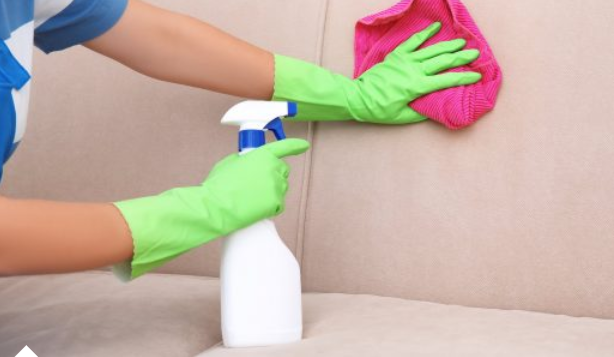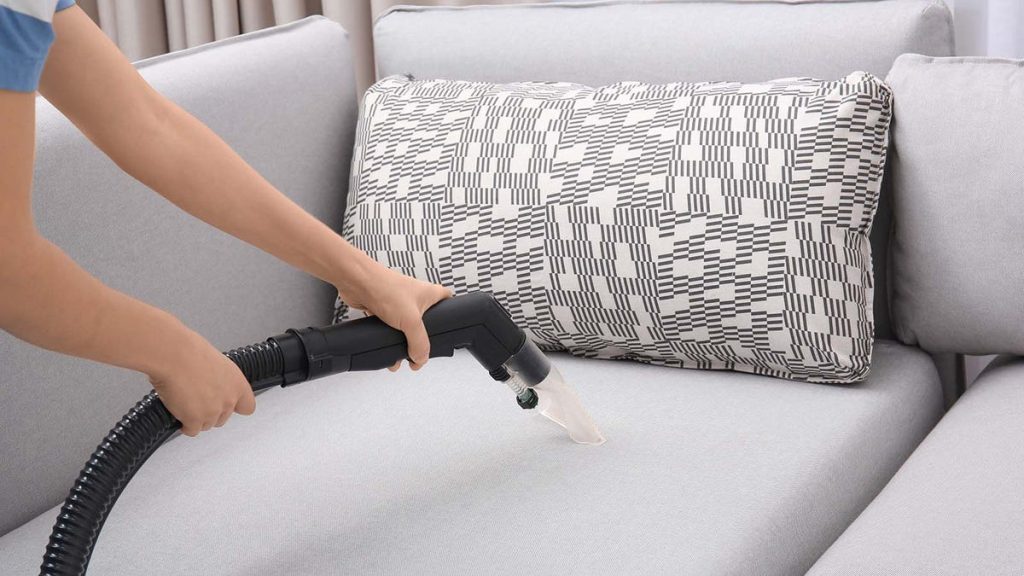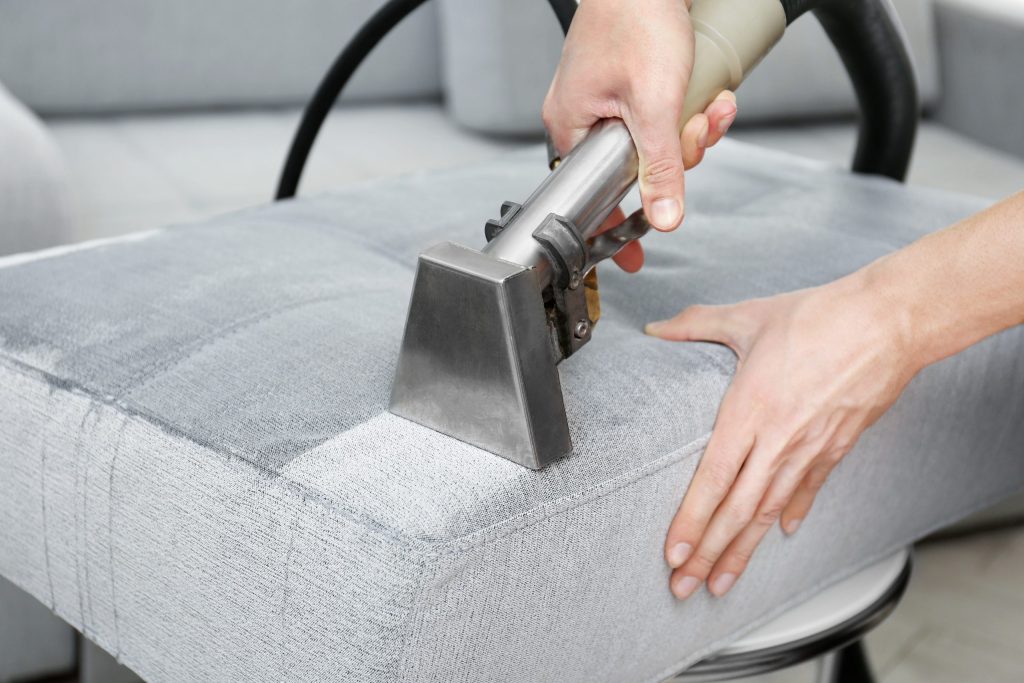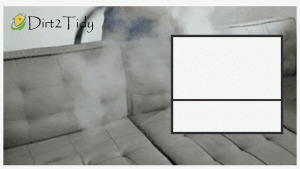It seems like the world is trying to keep our homes as dirty as possible. Dirt, dogs, kids, and cats, However, luckily, if you have enough time and resources, most of the cleaning problems can be solved. But there are some tricky problems, such as how can you keep your upholstery clean and looking good when everyone still climbs all over it?

It’s not like you can spray it and clean it, after all. Learn how to care for your upholstered furniture and keep updated on the Dirt2Tidy Blog with the new upholstery cleaning tips and tricks!
We are hard at identifying and producing useful content to help you stay safe and clean. Throughout Australia, we clean for clients, but these blog posts have data that will help everyone, regardless of where you live.
You may also read about: ” Upholstery Maintenance Tips “
Upholstery is the fabric and padding that covers the furniture, with upholstery fabric covered by sofas, love seats, armchairs, ottomans, stools, and more.
What Is the Washing of Upholstery?
How is it working?
The upholstery cleaning (as you would expect) is the cleaning process of the fabric that upholsters your furniture. But, at first, the process is harder than it could sound. Upholstery is mostly made up of relatively fragile natural materials, such as cotton, for one thing.
For another, most furniture would not allow you to literally remove the upholstery to pass through the washing machine.
You may also like to read about – “Homemade cleaner for washing machine“

Upholstery Cleaning requires special equipment and know-how. First, it inspects upholstery to note any tears or other damage. The fabric is then vacuumed, conditioned, rinsed, and dried with a vacuum.
Materials You’ll Need
To effectively clean your upholstered furniture, gather these essential tools and materials:
- Vacuum: Essential for removing dust and debris before deep cleaning.
- Cleaning brush: Useful for gently scrubbing stains without damaging the fabric.
- Upholstery cleaner or gentle laundry detergent: Choose a cleaner suited for your specific fabric type.
- Microfiber cloth: Ideal for blotting stains and drying surfaces without leaving lint.
- Steam cleaner: Provides a deep clean that can help refresh and sanitize.
You may also like to read about: ” How to Clean Upholstery? “
Another process is the extraction of hot water, also known as “steam purification.”
This is all happening again with advanced equipment — do not attempt a DIY job with a shampoo bottle and a standard vacuum cleaner. You’ll be sorry for what you did.
How to Clean Various Types of Furniture
1. Before you vacuum, still test
The trick is to always test upholstery cleaners or any other liquid you’ll use on furniture in an unnoticeable region. Different substances react differently. You can save yourself from making the wrong move by trying it out.
There are generally cleaning directions that come along with the upholstery, but we also suggest that you do a little test before cleaning the entire furniture.
You may also like to read: ” Do Upholstery Cleaning Yourself or Hire a Pro? “
How to Effectively Vacuum Upholstery
Keeping your upholstery clean requires a consistent and thorough vacuuming routine. Here’s how to vacuum your upholstered furniture for optimal cleanliness:
- Choose the Right Vacuum
Invest in a vacuum cleaner with strong suction power and a HEPA filter. This setup captures dust, allergens, and pet dander, ensuring a deeper clean. - Cover All Surfaces
Don’t just focus on visible spots. Make sure to vacuum every part of the upholstery:- Sides and Back: Dust accumulates everywhere, so even parts up against a wall need attention.
- Cushions: Use the crevice tool to access the gaps between cushions and the furniture frame. If your cushions are removable, flip and vacuum both sides.
- Regularly Clean Hard-to-Reach Areas
Occasionally, tilt your furniture to vacuum the bottom. This area traps dust and debris over time.
Bonus Tip
For an added layer of cleanliness, consider a vacuum equipped with UV light technology. This feature not only removes dust mites and allergens but also neutralizes bacteria and viruses, providing peace of mind in a healthy living space.
Vacuuming Upholstery: Essential Tools for Success
Maintaining clean and allergen-free upholstery is all about using the right tools. Here’s a guide to help you choose the best equipment for the job:
- High-Efficiency Particulate Air (HEPA) Filter Vacuum
To efficiently capture dust and allergens, such as pet dander, opt for a vacuum equipped with a HEPA filter. This type of filter traps tiny particles that can trigger allergies, ensuring a thorough clean. - Versatile Attachments
- Crevice Tool: Perfect for reaching those tricky spots between the cushions and the frame. It allows you to remove dust and debris that often get trapped in narrow spaces.
- Upholstery Brush: Gentle yet effective, this tool sweeps away dirt without damaging delicate fabrics.
- Removable Cushion Vacuuming
If your furniture has detachable cushions, make sure your vacuum can handle both sides. This not only extends the life of the cushions but also maintains the overall cleanliness of the piece. - UV Light-Enhanced Vacuums
For a deeper clean that targets bacteria, viruses, bedbugs, and dust mites, invest in a vacuum with an ultraviolet (UV) light feature. The UV light eradicates these hidden threats as the vacuum sucks them up, offering a higher level of sanitation.
Additionally, don’t forget to clean the underside of your furniture periodically. With assistance, tilt the piece to vacuum the frame’s bottom and keep dust at bay. Employ these tools to keep your upholstery spotless and your home healthier.
2. Cleaning cloth
It is good to begin by vacuuming the entire upholstery, particularly between the seams and between the corners, while cleaning fabric. Spray on the upholstery cleaner after having checked it in a dry position afterwards.
Then clean it gently off the cloth. Spray on some alcohol to get rid of an unwanted stain, then wipe it off. And always keep an eye on what hazardous substances are mixed in with cleaners so you can take advantage of the proper protection.
How to Vacuum the Sides, Cushions, and Bottom of Upholstered Furniture
Keeping your upholstered furniture clean requires attention to detail. Here’s a step-by-step guide to ensure no spot is missed:
Start with the Right Vacuum
Before you begin, ensure you have a vacuum with strong suction. Preferably, use one that features a HEPA filter to trap dust and allergens such as pet dander.
Step 1: Tackle the Sides
- Thorough Coverage: Run the vacuum over every surface of the upholstery, including areas that might be pressed against a wall or not in regular contact with people.
- Don’t Skip Corners: Dust loves to settle in hidden crevices, so make sure to cover all angles.
Step 2: Focus on the Cushions
- Deep Cleaning: Utilize the crevice tool to navigate spaces between cushions and the furniture frame. This will help dislodge and remove any debris that’s settled in tight spots.
- Full Access: If the cushions are removable, take them out. Vacuum both sides thoroughly to remove dust from every nook and cranny.
Step 3: Address the Bottom
- Gain Assistance: Carefully tilt the piece—enlist help if needed—to ensure you don’t damage the furniture or yourself.
- Thorough Collection: Vacuum the bottom frame as dust can accumulate in hard-to-see areas. Doing this once or twice a year keeps things fresh.
- Clean Flooring: Dust and debris often gather beneath furniture, so remember to sweep or vacuum the floor underneath regularly.
By following these steps, you’ll maintain not just the appearance but also the hygiene of your upholstered furniture, making your home a more welcoming space.
3. Cleaning with leather
It is quick to wipe leather materials out. Start vacuuming all the dust off, make sure you get any debris that can collect on the seams and corners, again. To give it a gentle scrub, you should then use a leather cleaner, but if you do not have that, then white vinegar is a decent substitute.
You may also like to read about: ” Do all carpet cleaners clean upholstery? “
But note that leather moisture appears to accumulate mildew, so be careful about the amount of leather cleaner you are using.
4. Cleaning the launderettes
Leatherettes are fairly easier to clean than upholstery of other styles. You may use liquid multifunctional washing, or even liquid dish soap would do the trick. Simply dab some on a wet cloth and smooth it over the leatherette. You should then wipe it down with a dry cloth after that.
If you have stains to deal with, gently clean the area with some nail polish remover. But be sure not to rub it too hard or else in the process it could lose some of its natural color.
Best Practices for Maintaining Upholstered Furniture
To ensure your upholstered furniture remains in top-notch condition over time, apply these essential care practices.
Routine Maintenance
Keep a lint roller nearby to effortlessly remove pet hair and loose debris from fabric surfaces daily. This keeps your furniture looking fresh between more substantial cleanings. Make vacuuming all cushions part of your weekly cleaning routine. For leather pieces, employ a soft, slightly damp cloth to maintain cleanliness and luster each week.
Stain Prevention
Guard against stains from the outset by using upholstery-friendly cleaners or investing in furniture covers. Take care with food and drink around upholstered surfaces, as certain stains such as oil and wine can be particularly stubborn. In the event of a mishap, act quickly to blot the stain, ensuring you follow any specific treatment guidelines indicated by the upholstery’s care instructions.
Eliminating Odors
If unpleasant odors arise, liberally apply baking soda to affected cushions. It’s a natural deodorizer that is both effective and gentle. Massage it into the fabric lightly with a soft brush, wait several minutes, then vacuum it away using an upholstery attachment. For more persistent odors, create a mixture of white vinegar and water. Lightly spray it onto the fabric, allow it to dry, and the odor should vanish. Combining the two methods—baking soda followed by a vinegar solution—can also deliver outstanding results.
Follow Manufacturer Guidelines
Check the care guidelines provided with your furniture for specific cleaning advice and warnings. Spot-test any new cleaning method on a discreet area first, as some treatments may not be suitable for all fabrics or dyes. If you are ever unsure, professional upholstery cleaning services offer a reliable solution. Always align with the manufacturer’s directions to avoid unintentional damage or fading.
By integrating these strategies into your care regimen, you can extend the life and appearance of your upholstered furniture significantly.
How Does UV Light Enhance Vacuuming to Combat Household Pests?
UV light is a powerful tool when included in your vacuum cleaner, particularly for dealing with bacteria, viruses, bedbugs, and dust mites. Here’s how it works:
- Germ Eradication: When a vacuum is equipped with UV light, the light targets and destroys the DNA of bacteria and viruses. This process renders these microorganisms inactive and unable to reproduce.
- Pest Control: For bedbugs and dust mites, the exposure to UV light disrupts their living environment, effectively reducing their populations. The UV light penetrates deep into surfaces where these pests often hide, helping to ensure they are eliminated.
- Efficient Filtration: After pathogens and pests are neutralized, the vacuum’s suction power aids in removing them from floors and fabrics. A dual filtration system often accompanies UV-enabled vacuums, capturing these particles and preventing them from re-entering the environment.
By combining UV technology with robust suction and high-quality filters, vacuums can significantly enhance home sanitation. This multi-faceted approach ensures your home stays cleaner and healthier, with fewer allergens and germs.
What are the advantages of Washing Upholstery?
The advantages of cleaning upholstery are close to those of regular carpet cleaning and other routine activities such as cleaning air ducts: increased quality of indoor air, allergens reduction, dust, dirt, grime, and more. In short, keeping things clean is the best thing to do (and is healthy).
You may also like to read: ” Revive Your Furniture Using Upholstery Cleaning Services “
How many times should you have washed your upholstery?
A few variables depend on the answer to this question.
Have you got children?
Have you got pets?
Do you work outdoors, or always track in dirt and grime?
If you replied yes to all of those questions, you probably should get the upholstery cleaned at least twice a year in your main living areas. If not, it should be performed once a year, or every 18 months.
Here’s a simple test to see if you’re due for a house cleaning: take a clean white cloth, moisten it with a little tap water, and rub it vigorously along the arms and back of your sofa or chair. If you can see the dirt coming from the rag upholstery, it’s time to clean it up.

How Often Should You Vacuum Upholstery?
Keeping your upholstery clean is vital for a fresh-looking home. For best results, vacuum your upholstery at least once a week. This regular maintenance helps in removing dust, dirt, and allergens before they settle deep into the fabric.
Why Weekly Vacuuming Matters
- Prevents Buildup: Dust and dirt can accumulate quickly, making it harder to clean over time.
- Improves Air Quality: Regular removal of dirt and debris helps maintain a healthy living environment.
- Extends Fabric Life: Consistent care can prolong the lifespan of your furniture by preventing wear and tear.
For households with pets or allergies, consider more frequent cleaning. Investing in a quality vacuum cleaner with an upholstery attachment can make this task easier and more effective. Remember, attentive care today ensures longevity and freshness tomorrow.
Homemade Cleaner
Do you know how to sweep up handmade tapestry?
What cleaners for your upholstery are safe?
How do you get tough pet flakes out?
These are topics we know nothing about, you have to buy consumer goods and you’ve hoped for the best. But you’ve tried to avoid chemical cleaners that can have hazardous ingredients, particularly at home where your kids spend so much time.
You want to know that your family and pets are protected from the cleaners you use, but you also want to know that they can do the job effectively.
You may also like to read: ” Furniture and Upholstery Cleaning “
Materials You’ll Need for Upholstery Cleaning
Before you start, gather these essential materials:
- Microfiber towel
- Solvent
- Vinegar
- Paper towel
- Distilled water
These items will help you tackle stains with confidence and ease.
The Best Homemade Cleaner Upholstery
Soap foam is one of the best homemade upholstery cleaners, especially for spot cleaning.
Sidenote: This recipe also forms the basis for an excellent DIY carpet shampoo.
Soap Foam Upholstery Cleaner Recipe
- 6 tablespoons of soap flakes
- 1 pint of boiling water
Instructions:
Blend six tablespoons of soap flakes with one pint of boiling water to make the foam. Let the mixture cool until it forms a gel, then whip it until a head of foam forms with a mixer or immersion blender.
Best Cat Urine Upholstery Cleaner
Pet urine stains and odor can easily tarnish your furniture, but with careful cleaning, you can save it. When dealing with pet urine on upholstery, you have two crucial objectives. First, it is essential to soak up the urine without allowing it to penetrate the cushions or filling material beneath the fabric. Once the urine seeps into the stuffing, it becomes nearly impossible to remove.
You may also read about: ” Furniture and Upholstery Cleaning “
Begin by blotting the area with paper towels or fabric to extract the moisture. Avoid rubbing, as it can spread the stain. If you have a wet/dry vacuum, use it to draw out the fluid before it has a chance to soak in.
You may also like to read: ” Upholstery Cleaning – Essential Facts and Upholstery Cleaning Tips “
Place a dry cloth over the spot and let it dry completely before proceeding with our pet stains homemade upholstery cleaner.
Materials You’ll Need
- Paper towels
- Dry cloth
- Wet/dry vacuum (optional)
Animal Stains Homemade Upholstery Cleaner
- 1/2 cup water
- 2 1/2 cups vinegar
- (Optional) Hydrogen peroxide
Add vinegar to the water and mix. Use it sparingly to dampen the stain, then lift the moisture with a dry cloth. For added odor removal, incorporate a small amount of hydrogen peroxide. Be careful not to push the urine further into the underlayer; avoid soaking the material.
Repeat the dabbing and drying process until the stain diminishes. Adding a small amount of essential oil to the water and vinegar mixture can enhance the scent and serve as a DIY furniture polish.
The next step is to sprinkle baking soda on the stain. Cat urine is acidic and can damage fabric. Baking soda neutralizes the acid, deodorizes the area, and acts as a natural fabric freshener.
Work the baking soda into the fabric and let it dry, then vacuum it up. If any mark or odor remains, repeat the entire process as necessary.
Additional Tips for Stubborn Stains
- Steam Treatment: For particularly stubborn stains, use steam to loosen them. An easy hack is to use an iron to apply hot steam to the stain, then treat it with your cleaner.
- Fabric Codes: Always check your upholstery’s cleaning code to ensure the methods and solutions you use are safe for your fabric type.
You May Also Like to Read:
” Upholstery Cleaning – Essential Facts and Upholstery Cleaning Tips “
By following these steps, you can effectively remove pet urine stains from your upholstery while preserving the integrity of the fabric.
How to Make Homemade Car Cleaner
Of course, because most of the time we are in our cars, stains are bound to happen. Moreover, sweat and body odour can easily permeate fabrics on the interior of the vehicle. Car upholstery is just as easy to clean as it is for furniture in the home.
Only use some common household ingredients to make a quick car-upholstery cleaner. With some drops of essential oil, mix club soda, vinegar, and dish detergent. You will have an efficient cleaning solution that fixes practically every kind of stain that you can find in your vehicle. This recipe is perfect for car seats, carpets, headliners, and stain-cleaning car mats.

Best DIY Audi A4 Cleaner
1/2 cup soda or carbonated water from the club
1/4 cup of vinegar
2 tablespoons of detergent for dishes
⁇ 2 to 4 drops of essential orange or lemon oil
Tb1234 Tbsp;
A shop vacuum or a steam cleaner, a spray bottle, a scrub brush, and our homemade car fabric cleaner are required to clean your car upholstery. A minor variation of this recipe can also be used as a carpet cleaner for DIY vehicles. Spray the cleaner generously on the upholstery, mats, or carpet and let it soak in for three to five minutes.
To raise the dirt, brush the stains in tiny circles, then spray the region with water and vacuum it up. Steam washing car seats quickly rinse out the cleaner. Enable the area to dry thoroughly to prevent mould or mildew from deep settling within the upholstery.
For a more effective approach, follow these comprehensive steps:
- Blot and Remove Solid Debris: If dealing with a fresh liquid stain, start by blotting as much moisture as possible using paper towels. For sticky solids like cheese or mayonnaise, gently lift away as much of the stain as possible with the edge of a dull knife or a credit card. Avoid rubbing, as this can push the stain deeper into the fabric fibers. For dried stains, a soft-bristled brush can help loosen the debris.
- Prepare a Cleaning Solution: In a small bowl, mix 1/4 cup of dishwashing liquid with 1 cup of warm water to create a cleaning solution. Use an electric mixer or whisk to generate suds. This solution will help break down the stain without damaging the upholstery.
- Rub the Stain: Dip a sponge into the suds, then gently rub the stained area. Ensure you move to a clean section of the sponge frequently to avoid reapplying the stain. This careful, methodical action helps lift the stain effectively.
- Rinse and Dry: After cleaning, dip a sponge or microfiber cloth in clear water and blot the area to remove any leftover cleaning solution. This rinsing step is crucial to prevent detergent residues from attracting more dirt. Let the upholstery air dry completely, avoiding direct sunlight or heat to prevent damage.
These steps, combined with the initial brushing and vacuuming, provide a thorough strategy for tackling even the toughest upholstery stains while ensuring the fabric remains in top condition.
The scent of the vinegar is heavy and can take a few days to fully air out. Using essential oil helps with the scent of vinegar, but if needed, you can leave it out. If you don’t like citrus, you can use other essential oils such as lavender or cedarwood too.
You can use some detergent for the dish but do not use detergent for the washing. I prefer a decent detergent with degreasing. Notice that, as it might harm them, you should not use this cleaner on leather car seats. Find tips in our unique homemade leather cleaner recipes here on the best methods for leather cleaning.
Homemade Cleaner Alcohol and Vinegar Upholstery
This is a fast and simple cleaner to produce, and for removing stubborn stains such as ink, it is the best upholstery cleaner. It is also one of the best sofa, mattress, and chair upholstery cleaners available. On furniture with a specified WW cleaning code, do not use this cleaner. There are several stubborn stains removed by the rubbing alcohol and white vinegar gets the rest. Optional are the essential oils but they give a good scent to the cleaner.

DIY Upholstery Alcohol and Vinegar Cleaner
Creating an effective cleaning solution for stain removal involves a few simple steps. Follow this guide to ensure your upholstery looks fresh and clean:
- Gather Your Ingredients:
- 1/2 cup rubbing alcohol
- 1/2 cup distilled white vinegar
- 3 to 4 drops of your favorite essential oil
- Tools You’ll Need:
- A small spray bottle
- A clean microfiber sponge or towel
- Mix the Solution:
In a small spray bottle, combine the rubbing alcohol and distilled white vinegar. Add 3 to 4 drops of essential oil for a pleasant scent. Ensure the spray bottle is set to mist to avoid saturating the fabric. - Application Process:
Spray the stained area lightly and scrub gently with a clean microfiber sponge or towel. The microfiber material helps lift stains without damaging the fabric. - Repeat as Necessary:
Continue spraying and scrubbing until the stain is fully removed. Be patient, as some stains may require multiple applications.
This method is a natural and effective way to tackle tough stains while leaving your upholstery smelling fresh. Always test a small, inconspicuous area first to ensure the fabric’s colorfastness.
Although this solution is suitable for washing, it also works well to eliminate the scent of mould from a vehicle or other unpleasant smells. Let the spot dry.
For any stain, it is important to clean the sofa or cloth as soon as possible when spills occur, then do a thorough cleaning of the upholstery when it is convenient. After a stain has set in, more effort will be required to get it out, so it’s preferable to get a swift answer.
For a DIY suede cleaner, this is particularly true. You’ll find that these four strategies for cleaning upholstery will take care of most of the stains that occur during regular daily usage.

Do it yourself Washing upholstery
Unlike common belief, upholstery cleaning doesn’t require fancy steam cleaning equipment connected to a vehicle. With or without equipment, you can make your upholstery look clean and smell new.
Choosing the right solution for Upholstery clean
Cleaning upholstery is broken down into two distinct groups: dry cleaning and wet cleaning. Dry cleaning uses solvent-based cleaning solutions whereas water-based chemicals are used in wet cleaning. Decide which one to use is as simple as testing the care label found under most furniture’s cushions.
Understanding Upholstery Codes
Most furniture will have a tag with one of the following codes: S, W, SW, or X. Here’s what they mean and how they guide your cleaning practices:
- Code W: This code indicates that you can use water to clean the upholstery. It’s important to note that the upholstery can be spot-cleaned with water or a water-based cleaner, but this does not mean the item is machine washable.
- Code S: Representing solvents, this code suggests using solvent-based cleaning agents like acetone and methanol, which are effective for oil-based messes. For best results, it’s wise to enlist a professional dry cleaner for major stains or annual deep cleaning. Spot clean with a dry cleaning product for smaller areas.
- Code SW: If your furniture has this code, you have the flexibility to use both water-based cleaners and dry cleaning solvents. A pro tip is to perform a spot test to decide which method is best. In some cases, it may be beneficial to leave the cleaning to a professional to avoid damaging the fabric.
- Code X: This code means that the fabric is not suitable for cleaning with liquids—no water-based solutions or dry cleaning solvents should be used. For these pieces, regular vacuuming or brushing with a soft bristle dry cleaning brush is recommended.
Testing and Professional Advice
In the absence of a care tag, test a cleaning solution in an inconspicuous section of the upholstery. Check for loss of color and shrinking of the fabric. If you’re still uncertain, consulting a specialist can provide peace of mind and ensure your upholstery remains in great condition.
The Easiest Way to Clean Upholstery
When it comes to refreshing your upholstery, using a steamer is arguably the simplest and most effective method. Steam cleaning not only eliminates dirt but also sanitizes the fabric, making it a two-in-one solution.
Using a Steamer
- Preparation: Start by vacuuming the upholstery to remove loose dust and debris. This step ensures the steamer can perform efficiently.
- Steam Cleaning: Fill your steamer with water and allow it to heat up. Gently glide the steamer over the fabric in steady, even strokes. The steam loosens dirt and kills bacteria, leaving your upholstery looking and feeling fresh.
- Drying Time: Allow the upholstery to dry completely to prevent any moisture-related issues, such as mold or mildew.
Alternative Solutions
If you don’t have access to a steamer, there are still easy ways to clean your upholstery:
- Dish Soap and Water: Mix a few drops of mild dish soap with warm water, creating a soapy solution. Use a clean cloth to gently blot and scrub the fabric.
- Vinegar Solution: Combine equal parts of water and white vinegar in a spray bottle. Lightly spritz the fabric and blot with a clean towel. Vinegar helps to deodorize and remove stains.
- Baking Soda Magic: Sprinkle baking soda over the fabric, let it sit for about 15 minutes, and then vacuum it up. This method is excellent for neutralizing odors.
By considering these methods, you can easily maintain your upholstery without the hassle of complex cleaning techniques.
Wet Purification Method: Steam Extraction
If a machine is available, steam extraction, also known as hot water extraction, is simple to perform. Connect the upholstery wand to the unit, and apply the cleaning solution recommended. Remove loose upholstery cushions, set aside for subsequent cleaning.
Place a clean towel at the upholstery base to catch drips. Apply the fabric with the wand; press the button to release the cleaning solution while drawing the wand towards yourself. Repeat as needed.
Take many dry passes over the upholstery to remove excess moisture when a small section is finished. With each cushion, begin.
Rinsing and Final Drying
After cleaning, it’s essential to rinse the upholstery effectively to ensure no cleaning solution residues remain:
- Rinse with Plain Water: Use a fresh sponge or cloth dipped in plain water to gently wipe the upholstery. This step helps remove any lingering cleaning agents.
- Blot to Absorb Moisture: Follow up by blotting the fabric with dry cloths to absorb excess moisture. This prevents water spots and speeds up the drying process.
- Use Air Circulation: Position a circulating fan nearby to expedite drying, but avoid direct heat sources like a hair dryer that could damage the fabric.
By integrating these steps, you ensure not only a thorough cleaning but also a safe and effective drying process for your upholstery.
Rinse and dry thoroughly. After completing the initial dry passes, dip a sponge or microfiber cloth in clear water and blot away any remaining cleaning solution. It’s crucial to ensure all detergent is removed, as residue can attract more dirt over time. Once you’ve blotted the area, allow it to air dry completely.
Avoid direct sunlight or heat. To prevent any damage, make sure the upholstery dries away from direct sunlight or heat sources. This careful drying process helps maintain the fabric’s integrity and appearance.
The wet method of cleaning: Hand-shampoo
A bucket, sponge, several white terry cloth towels, and upholstery shampoo are necessary for hand shampooing. It is possible to buy anything at a home improvement store. Make sure you buy a shampoo that states that it is suitable for hand-shampooing upholstery, without any machinery.

Mix the shampoo according to directions from the manufacturer. Agitate the mixture with a towel. Wring a decent amount of suds out of the sponge and scoop. As above, begin with the upholstery’s body. In a circular motion, add the suds to the cloth.
Blot with a clean terry cloth towel after a segment has been finished. Gentle agitation is good, but as this could harm the upholstery, avoid rubbing the fabric. Repeat as needed.
Dry Wash (Upholstery clean)
Dry cleaning is similar to hand shampooing; however, suds are not created by the solvent. So dip the sponge into the solution; wring it out; add in circular motions to upholstery. Continue shampooing the same way as aside. Make sure clean towels are blotted out.
Make sure that the work area is well ventilated and free of any open flames when using solvents since most solvents are flammable.
What Stains does Will Raise Out Professional Upholstery Clean?
If you’ve ever tried to keep your new couches clean and free from stain and have a house full of people, then you know how difficult this can be. When you first buy it or pick a substance that is less likely to show dirt, you could splurge for the security kit, but in the end, it’s a constant struggle for everyone who cleans the home to contend with.
Meat smudges, dirt, and pen marks from soiled work clothes. There’s almost no stain you haven’t seen or tried to clean up on your couch before if you’ve had it for a while. The good news is that to get this out, it doesn’t take more elbow grease or baking soda.
For your part, it means less effort. Hire a specialist cleaning firm with the equipment and skills to put your costly sofa back to an impressive state. Here are some of the kinds of stains that have been known to get out of upholstery by experts.
- Dander Cat & Flecks
- Certain allergens and airborne bacteria in the home
- Small juice and stains of food
- Unknown crusty substances
When a professional cleaning company is called in to assist with the cleaning of your upholstery they will determine the type of fabric and any possible harm or problems that might arise when attempting to clean the floor.
They will vacuum the cloth, condition, rinse, and dry it after they have understood the necessary procedure.
In some situations, as a procedure to try to raise a stain out, they can also use a method called hot-water extraction or steam cleaning.
Specialized equipment and procedures are used to do all of this. It’s not something you can do as a DIY project if you’re uncertain about the end result that may worsen the stains. The trained professionals of Dirt2Tidy often clean your upholstery so that fragile fabrics are given the utmost treatment.
Post-customer inspections ensure that you are pleased with the finished product, except with those stains that will literally never come off.
Upholstery Cleaning Services
As we have said earlier, cleaning upholstery is best left to the experts. We don’t recommend it, even though you can rent cleaning machines from several hardware or appliance rental stores. Professionals have access to better facilities and a larger amount of experience.
If you’re in Australia, Dirt2Tidy offers dependable professional upholstery cleaning services across Australia. Get in touch or make an appointment @dirt2tidy.com.au or call us at @ 0280034515.






